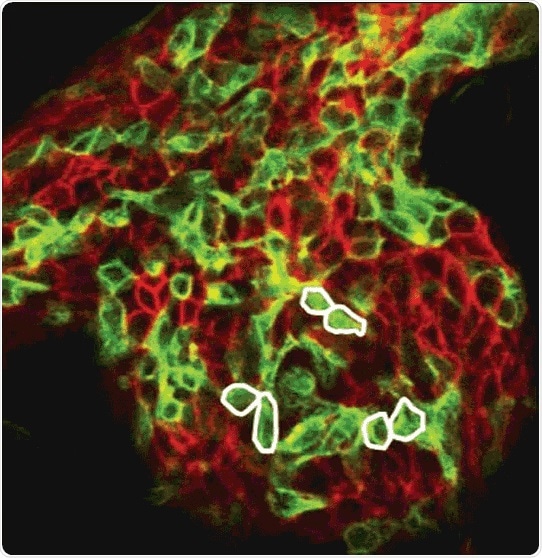Human life without stem cells is unimaginable. Because of stem cells, a cluster of cells turns into an organ, tissues of the human body can be constantly renewed, and a fertilized egg develops into a baby.

Live imaging of stem cells randomly moving in the mammary gland tissue. Five consecutive microscopic images of the mammary gland, taken over 8 hours, show the random movement of stem cells that make the cells spread through the tissue. All cells of the same lineage are marked. Image Credit: © Colinda Scheele/Institut Oncode.
However, it is not known what actually constitutes a stem cell. For example, how do these stem cells know when to divide to substitute a dying cell? Are stem cells a stable population of uniquely gifted cells?
At the Institute of Science and Technology (IST) Austria, researchers have found that stem cells are likely to arise because of the universal behavior of cells inside the organs. The group observed that the shape of the surrounding tissue, together with the pattern of apparently haphazard movements of the cells, established the function of the cell.
The researchers published their findings in Proceedings of the National Academy of Sciences on July 1st, 2020. Their findings might offer in-depth insights into the development and renewal of organs.
Stem cells are essential for the development and renewal of organs. In a majority of the organs, stem cells are situated in particular regions, and in a few cases, they can be detected through many intrinsic properties, such as molecular markers.
Stem cells are capable of differentiating into numerous cell types and dividing endlessly to create more numbers of stem cells. But does this indicate that the stem cell at the top remains immortal? Or can any type of cell overthrow this?
There is an open debate among the scientific community whether stem cells truly emerged from the collective dynamics of the tissue itself, or from the inherent cell properties.
In another situation, potential stem cells continuously compete to sit in specific “niche” areas. Every cell wants to outpace its neighbor by replication and, thus, constantly pushes them. The one that wins this race is the functional stem cell, while others will be pushed away from the niche; these losers differentiate and finally die.
In collaboration with scientists from the National Cancer Institute of Netherlands and the University of Cambridge, Hannezo’s team from IST Austria observed the mechanism to overcome these pushing forces away from the niche.
The scientists employed a live-imaging microscope to capture the movements of stem cells in the kidney, intestine, and breast tissues. They identified that apart from the constant flow and pushing forces, several haphazard movements were also present. Why would those be significant?
A famous saying in real estate business is ‘location, location, location.’ In the case of stem cells, this saying transfers to a location determining stemness (rather than the other way around). Then, random movements become key, as they allow you to get to the right location even if you started in the wrong one.”
Edouard Hannezo, Institute for Science and Technology Austria
Within that framework, the tissues appear similar to the exit of the subway station in the rush hour, with a few individuals able to arbitrarily turn back against the drift of the mass, attempting to take the subway again.
Under this metaphor, arbitrary movements are essential to allow the cells to move away from the niche of stem cells to ultimately go back to it.
We wanted to know what defines the number and dynamics of the stem cells, and to what extent this could be answered by mathematically exploring only the movements of the cells and the geometry of the organs.”
Bernat Corominas-Murtra, Study Lead and Scientist, Institute for Science and Technology Austria
The researchers then mathematically plotted this noisy cell dynamics into the organs’ geometry and could estimate, among others, the proportion of functional stem cells—the ones that can reach the right location on time, considering the amount of mobility/noise in the system.
The researchers found that stem cell regions developed naturally during the growth or renewal of tissues and without having to make assumptions on the cells’ molecular nature. The researchers, thus, demonstrated that the geometry and dynamics alone play a significant role.
You would expect that the randomness of cell movements blurs the properties of the system or makes it more unstable. Instead, it is key for the emergence of robust, complex patterns like the stem cell region, which remarkably coincides with the one previously identified using biomolecular markers of individual cells.”
Bernat Corominas-Murtra, Study Lead and Scientist, Institute for Science and Technology Austria
These findings contribute to the open debate relating to the nature of stem cells in tissues and possibly create new opportunities to understand the renewal of organs.
Source:
Journal reference:
Corominas-Murtra, B., et al. (2020) Stem cell lineage survival as a noisy competition for niche access. Proceedings of the National Academy of Sciences. doi.org/10.1073/pnas.1921205117.